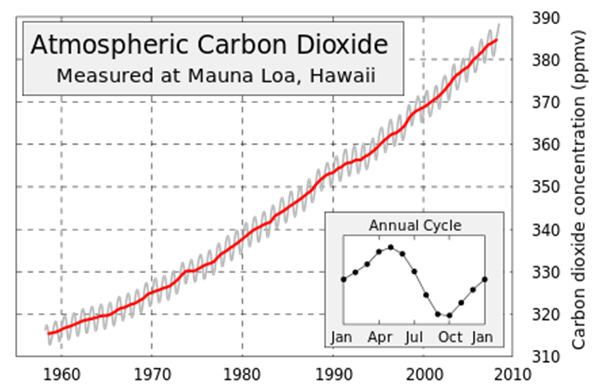I have blogged about the role of nuclear energy in curbing carbon dioxide emissions. I have blogged about the concern over water both as both a resource for and a threat to nuclear power plants. And I have had a lot to say about the costs of nuclear power. This first blog will discuss climate change, carbon dioxide emissions, and the economics of nuclear power. Tomorrow, I will talk about water and nuclear power then wrap it up.
Climate change is progressing much more rapidly than expected by previous models and projections. It has been estimated that anything over 350 parts per million of carbon dioxide in the atmosphere will lead to severe repercussions in terms of storms, droughts, ocean warming, etc. The atmosphere currently contains over four hundred parts per million of carbon dioxide.
Advocates of nuclear power generation claim that nuclear power is basically a carbon dioxide free source of energy. Unfortunately for the supporters of nuclear power as an answer to rising carbon dioxide levels, there is a great deal of carbon dioxide produced in the construction of a nuclear power plant as well as carbon dioxide produced by uranium mining, refining, transportation and waste disposal. Some estimates say that a nuclear plant has to run at full capacity for fifteen years to cancel out the carbon dioxide produced in the creation and fueling of a reactor. Reactors do need to be shut down for maintenance, refueling, troubleshooting, etc. so none of them run at full power for their lifetime. After their forty year license period, many are relicensed for another twenty years, but some relicensed power reactors have had to be shut down far short of their extended license because they are deteriorating with age and repairs can become too costly. So all in all, yes nuclear reactors could help with carbon dioxide emissions but they are not as helpful as some supporters suggest.
The cost of constructing nuclear reactors seems to just keep rising. During construction, there are often construction delays and cost overruns. The private sector is not too keen on investing in new nuclear plants for a variety of reasons. Without the Price Anderson Act which caps the liability of nuclear plant owners in case of serious accidents and the United States federal government's guarantee of multi-billion dollar loans for nuclear plant construction, it is doubtful if there would be any private investment at all. One of the benefits that nuclear power reactors have enjoyed in recent years is a guaranteed price for the electricity generated by the plant for decades. This makes investment more likely because the investors know that even if other sources of electricity proved to be cheaper than nuclear power as the years go by, the nuclear generated electricity will still bring in the same guaranteed price. Unfortunately for the proponents of nuclear energy, this type of guaranteed price support is going away and nuclear power will have to compete with much cheaper natural gas generators in the U.S. electricity market. On top of that, the price of uranium will be rising in the next few years because uranium production is projected to decline from now on. The U.S. has been burning plutonium from decommissioned Russia nuclear warheads for the past fifteen years at a lower price than the cost of new uranium fuel. It may be possible to breed fuel in breeder reactors but they have proven to be difficult to run and operate safely even after decades of global research. All in all, nuclear reactors for power generation will become more and more expensive in the future and will not be able to compete with other sources of electricity on a level playing field.
